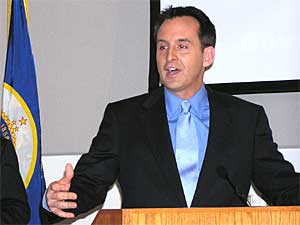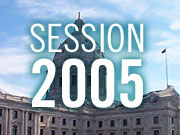January 26, 2005
 |
| Gov. Pawlenty has begun using the term "welfare health care" when referring to state-subsidized health insurance programs. Some say he's doing it to sway public opinion away from those programs. (MPR Photo/Mark Zdechlik) |
St. Paul, Minn. — Gov. Pawlenty has recommended eliminating about 27,000 people from the state's MinnesotaCare program as a part of his budget solution. During his budget address, he said the state's health care program costs are growing too fast.
"It is not fair to the rest of the obligations and responsibilities we have to stand by and say, 'It's OK to grow welfare health care at 27 percent, when we're also trying to fund K-12 education and transportation, and so many other priorities that I know Minnesotans want funded as well," Pawlenty said.
But the governor's characterization of MinnesotaCare as a welfare program is a bit misleading. The Minnesota Department of Human Services says less than 1 percent of the 90,000 adults on MinnesotaCare actually receive cash assistance from the state's welfare program. Another 3.5 percent receive food stamps.
In fact, supporters of the program say MinnesotaCare was created specifically with workers in mind -- to assure that those with low incomes had access to health care. Sen. Linda Berglin, DFL-Minneapolis, helped create MinnesotaCare in 1992.
"It certainly would help if we could stop having rhetoric about welfare health care costs. People who receive MinnesotaCare are working people. To characterize them as being on welfare is very misleading to the public, and very disparaging of hardworking Minnesotans," says Berglin. "These people are working and paying taxes. We'd like to keep them self-sufficient by making sure they have the low-cost health care they need, so they can continue to be working and to be paying taxes."
Berglin says everyone on the program pays premiums and co-pays, so they're contributing somewhat to their insurance costs.
Another architect of MinnesotaCare says Pawlenty should be happy that MinnesotaCare has been providing care to low income Minnesotans. Paul Ogren served in the Minnesota House from 1980-1992. He says MinnesotaCare and other state health care programs have kept Minnesota's rate of the uninsured the lowest in the nation.
"To the extent that there is welfare at play, it is the government bailing out employers who fail to provide this essential health insurance benefit to their employees," Ogren says.
Ogren says he suspects Pawlenty is using the term "welfare health care" in the hopes of smothering public outcry over his proposed health care cuts.
An expert on welfare reform agrees with that assessment. Sanford Schram, a professor of social work at Bryn Mawr College in Pennsylvania and author of several books on welfare reform, says the governor is using the term "welfare health care" because the public tends to think of health care as a right. By linking health care with welfare, he's trying to sway the public into thinking it's a handout.
"To push that button -- to call something 'welfare' and to say it's a handout is to begin to remind people that it's a form of dependency -- like some other kind of dependency," says Schram.
For his part, Pawlenty hasn't shied away from the phrase. During his budget announcement, he said it helps remind the public that this is a subsidy provided by the state.
"These are programs that the government provides in the area of social services. And I think calling it 'welfare health care' gives the public a sense that we are giving a social service or a welfare benefit in the health care area to people who are in need," said Pawlenty.
But that argument could be made for almost any state subsidy. Tom Pingatore enrolls low-income Minnesotans on subsidized insurance in Hennepin County. He says Pawlenty has offered tax breaks to businesses to help lure jobs to the state. Pingatore says Pawlenty chooses to call those subsidies tax incentives instead of welfare.
"In extreme cases, people have called attention to when businesses are bailed out, that it's a form of corporate welfare. But there's not that stigma attached," says Pingatore. "I don't think you see corporations hanging their head in shame about collecting welfare."
Pingatore says he would prefer if Pawlenty and other state lawmakers would ratchet down the rhetoric a notch. He says he would prefer to see Pawlenty and state lawmakers spend less time characterizing the people on state subsidized insurance, and spend more time finding a way to insure more people at lower costs.





